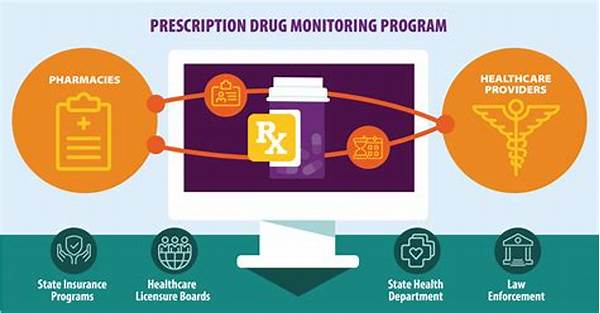Prescription drug monitoring programs (PDMPs) represent an essential component in the healthcare system aimed at mitigating prescription drug abuse and enhancing patient safety. With the proliferation of controlled substances, the requirement for such programs has intensified. PDMPs assist healthcare providers in identifying potential prescription drug misuse and fostering responsible prescribing practices while promoting collaborative patient management. By maintaining a comprehensive database of prescribed medications, these programs aid in preventing the potential dangers associated with over-prescription and adverse drug interactions. Consequently, PDMPs serve as a vital tool in the concerted effort toward reducing opioid misuse and improving overall public health outcomes.
Read Now : Safe Medication Combinations Guidelines
The Functionality of Prescription Drug Monitoring Programs
Prescription drug monitoring programs are electronic databases that collect data on prescriptions for controlled substances. Healthcare professionals utilize these databases to make informed decisions about prescribing and dispensing medications. The main goals of PDMPs include reducing the misuse of prescription drugs, decreasing the incidence of drug overdose deaths, and supporting the appropriate use of pharmaceutical drugs for genuine medical needs. By offering clinicians detailed insights into a patient’s prescription history, PDMPs help in the early identification of potential drug abuse and diversion. Furthermore, these programs empower pharmacists by enabling them to verify the legitimacy of prescriptions, thus reinforcing the integrity of the supply chain. In turn, PDMPs contribute to a more coherent public health strategy focused on minimizing the impact of drug addiction while ensuring that patients have access to crucial medications when necessary.
Advantages of Employing Prescription Drug Monitoring Programs
1. Prescription drug monitoring programs offer healthcare providers comprehensive insights into patients’ prescription histories.
2. They play a pivotal role in identifying potential instances of prescription drug misuse and contributing to public health safety.
3. PDMPs support efficient medical practices, enabling more informed decision-making regarding patient treatment plans.
4. By reducing prescription drug abuse, these programs aid in lowering the incidence of drug-related fatalities.
5. Enhancing communication between healthcare providers and pharmacists, PDMPs facilitate accurate and appropriate dispensing of medications.
Challenges Faced by Prescription Drug Monitoring Programs
While prescription drug monitoring programs offer significant benefits, they encounter challenges that require systematic solutions. One major issue is the variance in the implementation and use across different regions, leading to inconsistent data collection and utilization. To overcome this, efforts should be made to standardize these programs nationally, ensuring uniformity and enabling effective cross-state communication among healthcare providers. Additionally, there is a need for continuous education for both prescribers and patients on the proper use of these programs to maximize their effectiveness. Another challenge relates to patient privacy concerns, which necessitates stringent measures to protect sensitive information within these databases. Addressing such challenges is crucial to optimizing the roles of PDMPs in public health domains, ultimately fostering safer drug prescription practices while maintaining high standards of data security.
Read Now : Emergency Care Team Leadership
Leveraging Prescription Drug Monitoring Programs for Improved Healthcare
Prescription drug monitoring programs have demonstrated their potential in transforming healthcare practices by enhancing the quality of prescription processes and patient safety. Implementing these programs across various healthcare settings ensures that prescribers and pharmacists possess the requisite information to make informed decisions. Innovative integration of PDMP data with other healthcare systems could promote greater efficiency and accuracy in managing patient treatments. Furthermore, by fostering interdisciplinary collaboration, these programs can drive the development of comprehensive care models that address the multifaceted challenges of prescription drug dependency. These approaches not only advance public health objectives but also reinforce the responsible use of medications, thereby contributing positively to the broader healthcare system.
Enhancing Opioid Safety through Prescription Drug Monitoring Programs
Prescription drug monitoring programs are vital in addressing the opioid epidemic by curbing the risk of misuse through informed prescribing decisions. With systematic adoption, these programs serve as a robust mechanism in ensuring medication safety and reducing overdose rates. PDMPs grant healthcare professionals timely access to patients’ prescription data, empowering them to identify patterns indicating potential opioid misuse. This proactive approach aims to balance the provision of pain management solutions with efforts to prevent drug dependency. Moreover, PDMPs facilitate strategic public health interventions, emphasizing the importance of collaborative efforts between medical professionals, policymakers, and community stakeholders. Through this synergy, the healthcare system can enhance its capacity to combat opioid misuse while ensuring patients receive appropriate and necessary care.
Future Directions for Prescription Drug Monitoring Programs
As the landscape of prescription drug use evolves, prescription drug monitoring programs must adapt to emerging challenges and opportunities. Emphasizing technological advancements and data integration can amplify the efficacy of these programs, ensuring that healthcare providers have access to the most accurate and comprehensive information. Moreover, fostering a culture of routine PDMP utilization among prescribers can lead to improved outcomes in preventing prescription drug abuse. Legislative support at both state and federal levels can further enhance the capability and reach of PDMPs, promoting uniformity and enabling seamless cross-state collaboration. The dedication to continuous improvement and innovation in these programs is essential for tackling the complex issues surrounding prescription drug use, ultimately advancing public health objectives.
Summary of Prescription Drug Monitoring Programs
In conclusion, prescription drug monitoring programs play an instrumental role in safeguarding public health by mitigating the risks associated with prescription drug misuse. These programs provide healthcare professionals with critical insights into prescribing practices and patient behaviors, fostering informed decision-making and responsible medication use. Given the mounting challenges posed by the opioid crisis and other drug-related issues, the importance of PDMPs cannot be overstated. By promoting transparency, enabling real-time access to data, and facilitating cross-disciplinary collaboration, these programs can significantly alter the trajectory of drug-related public health outcomes. Continued investment in and development of PDMPs will be crucial to ensuring their adaptability and effectiveness in an ever-changing healthcare environment. Through these collective efforts, a robust PDMP framework has the potential to deliver impactful solutions, ensuring the safe and effective use of prescription drugs for future generations.
